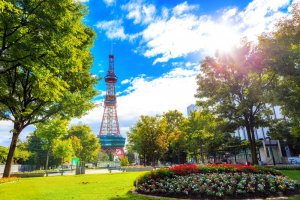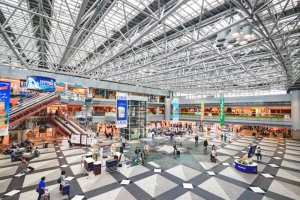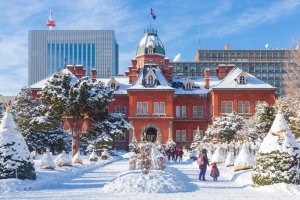Sapporo, the capital city of Hokkaido, is an exciting area, filled with memorable destinations and activities. The prefecture’s remarkable airports, railways, buses, subways, trams, and taxis ensure that you have the means to achieve your desired itinerary.
Our access guide will help you efficiently navigate the urban landscape, giving you confidence in planning your next adventure!
Orientation–Where is Sapporo?
Sapporo is located on the southwestern coast of Hokkaido, Japan’s northernmost island.
This capital city serves as Japan’s fifth-largest city and is known internationally for its annual Sapporo Snow Festival, verdant parks, art museums, Sapporo TV Tower, and beer industry! Foodies will also love the city’s signature ramen, seafood, and fresh Hokkaido ice cream.

Getting to Sapporo
By Plane
The most common way to fly into Sapporo is on a domestic flight from Tokyo, Osaka, Nagoya, or Fukuoka to New Chitose Airport, located just southeast of Sapporo. This regional airport is an international and domestic travel hub known for its entertaining shops and activities.
Common flight routes and travel times include:
- Haneda Airport (Tokyo) to New Chitose: 90m
- Narita Airport (Tokyo) to New Chitose: 1h and 50m
- Osaka International (Itami) Airport to New Chitose: 1h and 45m
- Osaka Kansai International Airport to New Chitose: 2h
- Chubu Centrair International Airport (Nagoya) to New Chitose: 1h and 45m
- Fukuoka Airport to New Chitose: 2h and 20m
Currently, there are no flights due to Covid, but before Covid, Finnair (Finland) and Qantas (Sydney) flew to Shin-Chitose, and at present Finnair has announced that they will resume flights from July this year, so we believe access from Europe and Australia will become more common here once they resume flights.
International flights mostly originate from across Asia (e.g. South Korea, Taiwan, China, Thailand, Singapore & Australia), with some others from further destinations, like Hawaii or Finland (Actual results in January 2020. As of January 2022, international flights are not operated due to the influence of the new coronavirus, so please be careful.). Domestic flights originate from all over Japan. The Tokyo—New Chitose route is one of the busiest in the world (9.7mill passengers carried in 2018), with up to 80 flights during normal conditions.

New Chitose Airport is well connected to Sapporo via airport buses and rapid JR trains; multiple buses and trains run every hour. Bus rides (1,100 yen) to Sapporo take about 70-90 minutes depending on the destination, and rapid JR trains (1,150 yen), which connect directly to Sapporo Station, take about 40 minutes.
By Train
While airway travel is the most time-efficient way to reach Sapporo, you can also travel by train via the Hokkaido Shinkansen Line, which uses the underwater Seikan Tunnel. From Tokyo Station, take a Tohoku-Hokkaido Shinkansen to Shin-Hakodate-Hokuto Station near Hakodate (4-hour ride). Then, transfer to the Ltd Express Super Hokuto train bound for Sapporo Station (3.5-hour ride). Please note that Hayabusa trains require seat reservations beforehand. This route is covered by both the JR Pass and JR East-South Hokkaido Rail Pass.
By Ferry
If you are traveling to Sapporo using a private car, you may want to opt for a leisurely ferry ride. Ferries depart from a number of locations in Honshu, including Maizuru, Tsuruga, Niigata, Nagoya, Oarai, and Hachinohe, and generally take around 20 hours, with farther locations taking up to 40 hours. These ferries connect to Otaru Ferry Terminal and Tomakomai West and East Port Terminals, which are about a 1-hour car ride to Sapporo.
Access from Sapporo to Hokkaido’s Cities
Sapporo Station serves as the central hub of Sapporo and is a common starting point for travel outside of the city. Hokkaido’s train system effectively connects the local Sapporo area with other regional cities in an efficient manner.

The below popular routes are all covered by the JR Pass.
- Sapporo to Otaru: 30-50 minutes, rapid or local trains on the JR Hakodate Main Line
- Sapporo to Asahikawa: 1 hour and 40 minutes, Okhotsk limited express train
- Sapporo to Niseko: 2 hours to Kutchan station via the Rapid Niseko Liner. Then take a bus or taxi to Niseko (15-45 minutes depending on the resort destination)
- Sapporo to Obihiro: 2 hours and 40 minutes, Tokachi or Ozora limited express trains
- Sapporo to Hakodate: 3.5 hours, Super Hokuto limited express train
- Sapporo to Kushiro: 4 hours and 30 minutes, Ozora limited express train
Similar to Hokkaido’s trains, its buses provide reliable and economical transportation to major cities in the region. The prefecture’s intercity bus system is centered in Sapporo with wide-spread reaches to popular destinations such as Niseko, Furano, Hakodate, Asahikawa, Otaru, Shiretoko, and more. Travel times vary greatly from 1 hour to nearby Otaru to over 7 hours to Shiretoko. Please note that some bus routes require reservations while others do not.
If you are planning on frequently utilizing the bus system during your stay, we recommend looking into the Hokkaido Inter City Bus Pass (ICBP) or Hokkaido Budget Bus Pass (HBBP). Details are listed in the Transport Passes section. The JR Pass also covers local JR buses in the Hokkaido area.

Getting Around Sapporo
Sapporo is one of Japan’s easiest cities to navigate thanks to its rectangular street design and intuitive addressing system, which labels locations based on their compass directions and the number of city blocks. For travel within the city, you will most often rely on subways, trams, buses, and taxis.
By Subway
The Sapporo Municipal Subway is a convenient way to travel around the city. The mostly underground subway consists of three lines, Namboku, Tozai, and Toho, all of which meet at Odori station. The subways are also connected to the city’s railways and buses, providing easy transfers to both. You can purchase subway tickets at automatic ticket machines located at all subway stations.
If you plan to use the subway multiple times in one day, purchase a One Day or Donichika Ticket. Details are in the Transport Passes section.
By Tram

Sapporo is one of the only cities in Hokkaido, the other being Hakodate, that has a tram, or streetcar, network. These brightly colored, sometimes vintage, and sometimes modern-looking trams are a fun way to get around the city, and, with their frequent running times, you do not have to worry too much about planning ahead. Just hop on and enjoy the ride!
The tram network in Sapporo, called Sapporo Streetcar, travels in a loop in the center of the city and many run every hour. The streetcars operate from 6:00 to around 23:00 and provide easy transportation to 24 stops, as well as connections with the subways. The entire loop takes a little under an hour and is an excellent way to explore central Sapporo. A single ride on the tram costs 200 yen for adults and 100 yen for children. If you plan on utilizing the streetcar multiple times a day, consider purchasing the One-Day Streetcar Pass or Dosanko Pass. Details are listed in the Transport Passes section.
Please note that the streetcars become crowded during peak travel times.
By Bus
Sapporo’s local bus network is centered on bus stations in and around Sapporo Station and run by three main bus companies–Hokkaido Chuo Bus, JR Hokkaido Bus, and Jotetsu Bus. These buses have multiple terminals throughout the city, connect directly to subway stations for seamless transfers, and provide transportation to further destinations not accessible by subway or tram. Bus fares in central Sapporo generally cost about 210 yen for adults and 110 yen for children. You can pay bus fares with cash or SAPICA, Kitaca, or other IC cards.
Other useful Sapporo bus services are Jotetsu’s 100 yen bus that runs between Sapporo Station and Susukino and Chuo’s Sapporo Walk Bus that runs from Sapporo Station to Sapporo Beer Museum and stops at several tourist locations in between. One-day bus passes for the Sapporo Walk Bus cost 750 yen for adults and 380 yen for children.
By Taxi
Taxis are a convenient way to travel around the city if you are carrying a lot of baggage or are looking for a less time-sensitive option. Taxis tend to congregate around Sapporo Station, department stores, hotels, and tourist attractions and come in three sizes: small, medium, and large. Taxi fares depend on the size of the car, the distance, and the time of day. Most taxi drivers do not speak English, so be sure to have your destination’s address in Japanese. Please note that you should not tip your taxi driver, as it is not customary in Japan, and you should confirm that the taxi accepts cash or credit, depending on your payment method, before departing.
Transport Passes

Below are a number of economically priced passes that help streamline your travels by eliminating the hassle of purchasing multiple tickets. Please note that the pricing below is up-to-date as of 2022.
Airways
-
JAL Japan Explorer Pass: This pass offers a fixed fee for domestic airway travel to over 30 cities in Japan. Fare prices range from 5,500 to 11,000 yen.
Trains
-
JR Hokkaido Rail Pass: This pass allows holders to ride all JR Hokkaido trains, except Hokkaido Shinkansen, and some JR buses. You can purchase 5- or 7-day plans, which cost 19,000/9,500 yen and 25,000/12,500 yen respectively for adults/children if you purchase it outside of Japan.
-
JR East-South Hokkaido Rail Pass: This pass offers unlimited train rides on valid routes in East Japan and Hokkaido for 6 days, including the Hokkaido Shinkansen, JR Hokkaido lines, and select JR lines from Tokyo to Hokkaido. The pass costs 27,000 yen for adults and 13,500 for children.
-
JR Tohoku-South Hokkaido Rail Pass: This pass offers unlimited train rides on valid routes in Tohoku and Hokkaido for 6 days, including the Hokkaido Shinkansen, JR Hokkaido lines, and select JR lines from Aizu to Aomori. The pass costs 24,000 yen for adults and 12,000 for children.
-
Japan Rail Pass: This pass allows holders to travel throughout Japan via eligible trains, buses, and ferries with Green Car and Standard Car options. You can purchase 7, 14, and 21 day passes, which range in price from about 29,650/14,820 yen to 83,390/41,690 yen for adults/children.
Subway
-
One Day Ticket: This ticket offers unlimited rides on the subway for a flat rate of 830 yen for adults and 420 yen for children.
-
Donichika Ticket: This discounted one-day pass is available on weekends and holidays and costs 520 yen for adults and 260 yen for children.
Buses
-
Hokkaido Inter City Bus Pass (ICBP): The ICBP allows users to take any bus in central Hokkaido without reservations. For adults/children, the pass costs 6,000/3,000 yen (3 days) or 9,000/4,500 yen (5 days).
-
Hokkaido Budget Bus Pass (HBBP): The HBBP works similar to the ICBP (above), except that it includes long-distance bus routes as well. Adult/child pricing for HBBP is 11,000/5,500 yen (3 days) or 17,000/8,500 yen (5 days).
-
Please note that sales for both passes are currently suspended as of May 1, 2020 due to Covid-19.
Trams
-
One-Day Streetcar Pass: This pass offers users unlimited rides on the Sapporo Streetcar for one day at a fixed rate. The pass costs 500 yen for adults and 250 yen for children.
-
Dosanko Pass: This pass offers one adult and one child unlimited rides on the Sapporo Streetcar for one day on weekends and holidays. The pass costs 370 yen.
IC Cards

-
SAPICA: This prepaid and rechargeable IC card can be used for subways, buses, streetcars, and even select shops in the Sapporo area. You can purchase the card at subway ticket machines and subway and bus ticket offices. The card initially costs 2,000 yen, which includes a deposit of 500 yen that will be refunded upon cancellation and an available balance of 1,500 yen. You can recharge this card at subway ticket machines and charging stations, subway and bus sales offices, and select stores.
-
Kitaca: This IC card, provided by JR Hokkaido, can be used for trains, subways, buses, streetcars, and select shops in the greater Sapporo area, as well as nationwide at marked IC stations. Similar to the SAPICA card, Kitaca costs 2,000 yen, which includes a 500 yen refundable deposit and an available balance of 1,500 yen.
-
You can also use the following IC cards for Sapporo’s subway, buses, and trams: Suica, PASMO, manaca, TOICA, PiTaPa, ICOCA, Hayakaken, nimoca, and SUGOCA.




































